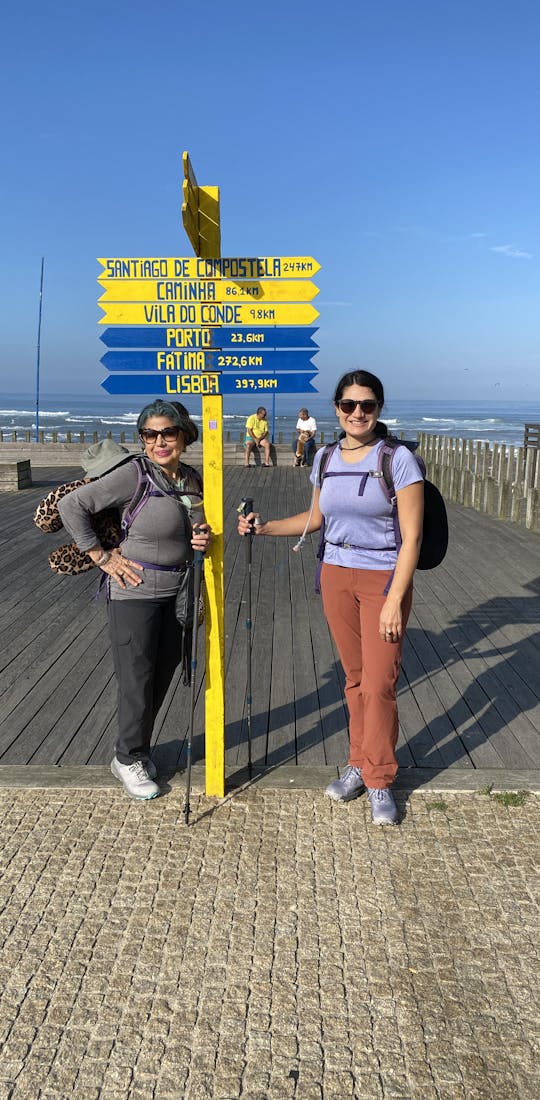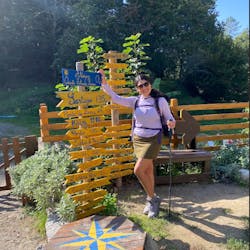It is my hope that this blog will inspire you to hike the Camino one day and especially hike it with your family.
I don’t exactly remember how I heard about the Camino De Santiago, but it sounded really nice. The Camino is typically walked as a pilgrimage for spiritual reasons. According to Americanpilgrims.org “As of December 9, 2023, more than 443,000 Compostelas have been issued by the Pilgrim's Office!”.
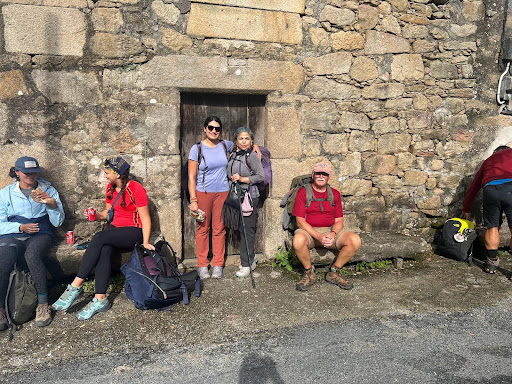
Our Why
My mother said to me one day, with desperation in her voice, that she wanted us to do the Camino de Santiago before she died. I never forgot that and had planned to hike it in 2020, but then COVID happened and our plans were derailed.
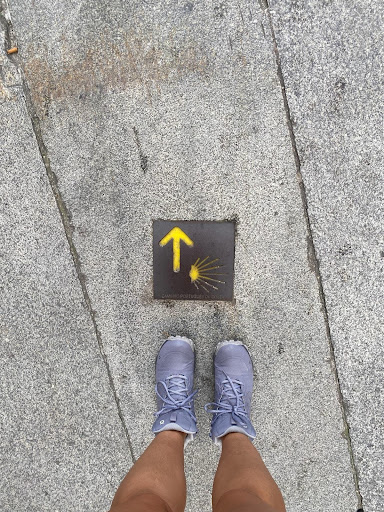
As I thought of 2023 goals, I knew I wanted to visit Portugal, and while reading the “Hiking The Camino De Santiago” book by Anna Dintaman and David Landis, found out there were alternative, shorter routes outside of the “French Way.” Knowing my mother had not hiked long distances and that I wanted to visit Portugal made picking the two-week trek from Porto to Compostella de Santiago an easy choice.
Commitment & Planning
After deciding on the trip, the next thing I did was book flights. This way I could set the goal in stone.
Now that my mom and I were committed, I knew I needed to start planning the route, book our stays, and get all the appropriate gear for a “buen Camino.” Of course, there would need to be physical fitness training!
I decided to start my research process and came across the Stingy Nomads Camino Portuguese guide, I ended up using their Itinerary as a template. Knowing how many miles we would cover every day and where we were going to start, and stop was important for training and picking our nightly stays.
Training
Training was easy as I commit to taking the 52 Hike Challenge every year and hiking is a weekly activity for me. I knew the most we would be walking on a given day was about 16 miles, so I made sure to hike 6-12 miles on any given day during the training period.
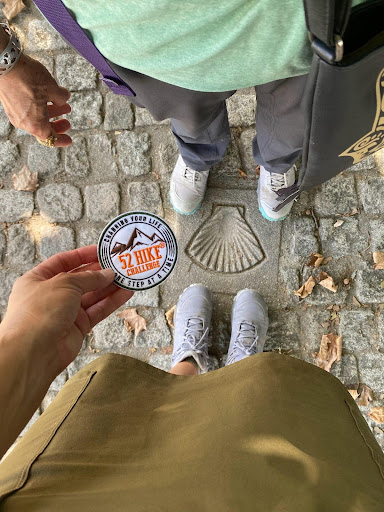
Tip: In order to get in shape for the Camino, start training no less than 8 weeks before.
Packing for the Camino
- 10 Essentials, including a hat, sunglasses, sun protection, emergency kit (make sure to bring blister care items), and more!
- A good day pack with a hydration reservoir and rain cover
- Hydraflask water bottle to keep drinks cool in the heat
- Oboz Waterproof Katabatic hiking shoes
- A rain jacket
- Puffy jacket for chilly mornings
- 2 pairs of bottoms (pants, shorts, etc.)
- Bring multiple breathable underwear and sports bras
- At least 2 pairs of wool socks, we used Darn Tough socks
- 2 to 3 lightweight breathable shirts, I used an REI Sahara T-shirt and an Outdoor Research echo hoodie
- Bandana for hot days and cooling yourself off
- 52 Hike Challenge Kula Cloth - please leave no trace!
- Trekking poles
- Packing cubes for organization
- Sandals for evening foot recovery
- Extra clothes for sleeping and lounging
- Journal for documenting your experience
- Battery Pack and charging cords
Logistics
One of the most surprising things on the Camino was how great services geared at pilgrims are. Whether you need luggage transport services, pilgrim hostels, or a good meal - the Camino provides. My heart and soul were blown away by the welcoming hiker culture the Camino has established! There were places that cater to pilgrims with daily peregrino meals, which include a starter, main meal, dessert, and drink (bonus are all the pilgrims you will meet there!). There are so many other amazing things such as all the churches, shrines, taverns, and cafes- where you can get your daily pilgrim credential stamps and stop for much-needed rest breaks.
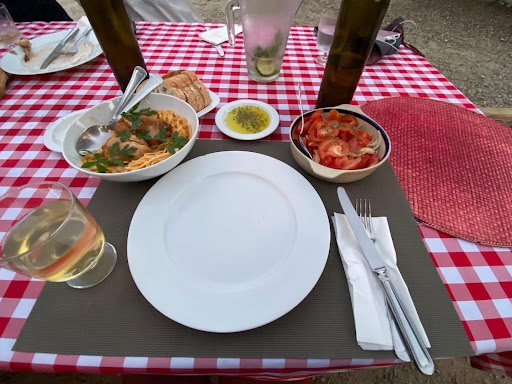
Traditionally pilgrims carry everything on their back and stay at Alburgues, which, according to Caminoguidebook.com, “allow pilgrims to sleep in dormitory-style accommodations for around 8-20 euros per night”. Since I was with my mom and because we planned to continue our travels after the Camino, I decided to pick hotel stays. This would also save us from bringing extra gear like a sleeping bag, sheets, towels, etc. Plus, it would be more comfortable. My next step was to book our hotels/stays according to the daily itinerary.
A word of advice: Make sure when booking your hotels that they are close to the trailhead entrances, we had a few mishaps where our hotel was quite far from the trail, so we did have to take a taxi a few times. You can verify this by reading the reviews, emailing, or calling the hotel. Also, make sure you actually map out mileage daily, some of the stays were at one end of the town, which meant extra miles. If you decide to go the traditional route and stay in Alburgues, you will definitely want to arrive as early as you can. We came across a few pilgrims who had not been able to get accommodations on a few occasions.

Luggage transport: You will want to decide if you will carry everything with you, or use a transportation service. We used Top Santiago to transport a duffel bag of our stuff each day. I can say that this service was invaluable for us. We paid around 8 euros for each day we used the service.
Make sure you check if your stay takes your luggage, on a few occasions our private stays didn’t, and we had to go pick up our bags somewhere else. At most, our luggage was a 5 to 10-minute walk from our place. This can be a logistical pain after a long day of hiking.
Tip: Consider bringing a collapsible and packable duffel bag for your trip to transport your gear around. This way it packs down light when not in use.
Get your pilgrim credentials: Since we opted to start in the Porto area, we picked up our pilgrim credentials (basically a passport book where you collect your daily stamps) at Se Cathedral. We got in the main long line by the museum/cathedral entrance, paid $3 for our booklets, and also opted to check out the cathedral, which was beautiful and really important to us. We sat in prayer and I did feel that was a big part of what my pilgrimage was about, “healing with my mother.”
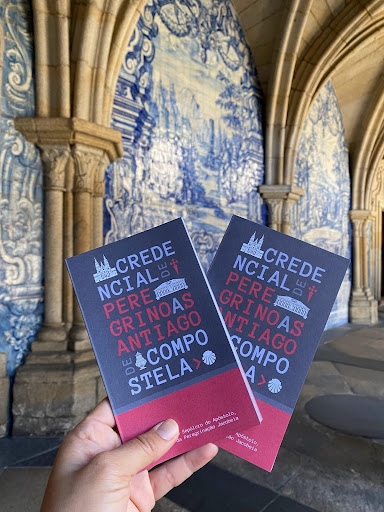
The scallop shell: Caminoways.com notes, “The scallop shell is one of the most iconic symbols of the Camino de Santiago… Painted on trees, sidewalks, tiles, etc… the scallop shell… will help you find your way to Santiago de Compostela.”
It is also a symbol that you are a pilgrim. There are many thoughts on using a shell while doing the Camino versus getting a shell once you complete the Camino. I opted to get our shells at the end of the trek. It’s what motivated me to continue each day. Whichever you choose is fine. I say do what feels right for you. It was lovely meeting pilgrims and seeing how they rocked their shells.
Route: We started on the coastal route and then hiked inland to the central route to Santiago de Compostela.
Our Trek, Reccomendations, & Journey
In this section, I will highlight some recommendations and experiences from the trek.
After getting into Portugal, I started honing in on additional planning details. After reading my friend Drew’s blog, Trail to Peak, and his experience hiking the Camino Portuguese, I opted to start our trek in Labruge instead of Porto. If you decide to start in Porto, I liked our stay there, BF Suites & Apartments. We started our actual journey by taking an Uber to our overnight stay at Smiling Places GuestHouse in Labruje, which caters to pilgrims. The stay was near the trail entrance and our host was incredibly kind. On the morning of October 3rd after a wonderful breakfast, we set off on the Camino with an ocean view. It was such a fantastic way to start our pilgrimage. We met our first father-and-son team and hiked with them for a while. It was really nice getting to know pilgrims and the reasons they were on the Camino.
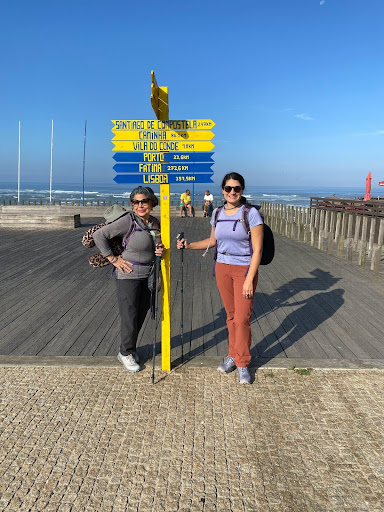
On our first day, Mom showed me her master foraging skills. This is forever etched in my heart and soul. She went on to teach me about many medicinal plants and herbs. Many times she would cook me a meal or make me tea with what she had harvested that day.

Tip: Have a pastel de nata (mini custard pie.) This should be a daily treat in my opinion!
We ended our first evening on the route in Arcos, Portugal. We had an amazing stay at Quinta Sao Miguel de Arcos. The location was right on the trail in an old stone family home that was converted into a pilgrims' lodge. This was where we met a ton of other pilgrims all attempting the same route during dinner. The food was fantastic. We met Emiko and James here, this was their 2nd Camino experience. I asked James why he was doing it again, he said I would figure that answer out on my own a few days in…

On our way to Barcelos the following day, we stopped at a cafe, Pedra Furada, in Rua Nova for a snack and break - the owner was adorable!
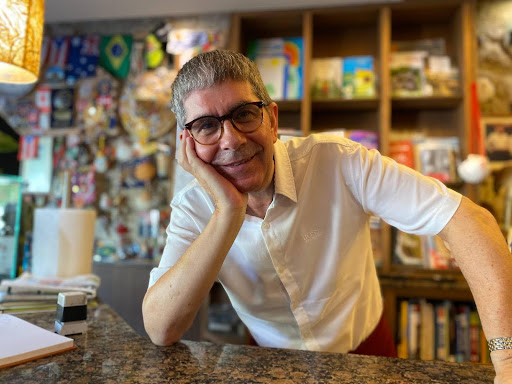
On the morning of October 5th, we met another father-son duo, Marcus and his son Philip. They were our first trail angels. They gifted us these lovely handmade hearts to carry on the way.
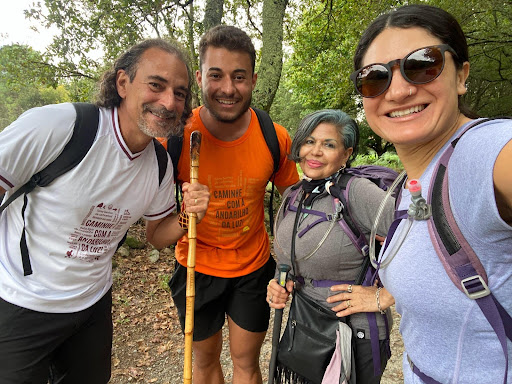
That evening we arrived at Vitorino Dos Piães and stayed at Estabulo de Valinhas. It was another one of my favorite stays. It was an old winery with incredible sunsets, the rooms had a minimalist design, plus they offered a pilgrim meal. I loved the location right on the Camino and the food was fantastic (they serve homemade dessert and wine.) Meeting other pilgrims during dinner was a highlight for sure.
Tip: Eat the meat bread, a delicacy only found at a cafe in the Ribeira town en route to Vitorino de Piães.
Another stop on the Camino Portuguese is the town of Ponte de Lima. It is a cute village with lots of photo ops. After passing the bridge, you can meet a lovely carpenter who does blessings and greetings for pilgrims. It was a highlight for sure - you can’t miss him!
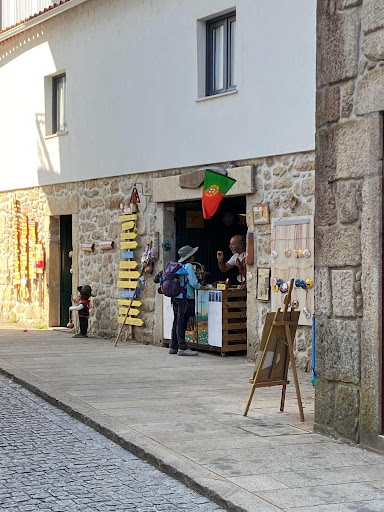
We arrived in Tui on day 5 of our Camino. We stayed at Guest House Clarevar. We liked that it was right on the trail and close to a yummy café where we enjoyed our tortilla Española (a yummy famous potato, cheese, and egg omelette) with our coffee before starting up on the Camino.
Tip: In O Porriño, make sure to stop at the mural for photo ops!
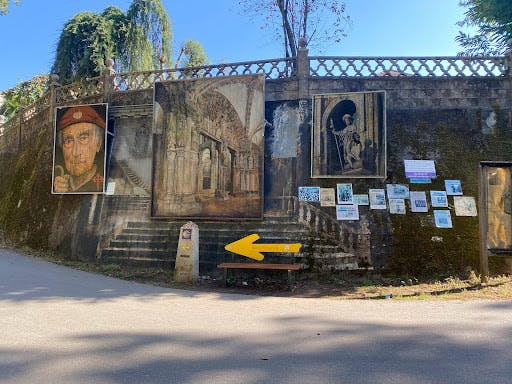
By day 7, we ran into our friends Emiko and James from our first evening on the Camino! We decided to have a glass of wine during our break. It was the first, but not last, beverage break with tapas on the Camino.
That evening we made it to Redondela where we stayed at Casa D’Mina. Another favorite place we stayed at! The house is decorated nicely, with lovely rooms and hammocks for relaxing. This is where we met our trail family, Anders, Tali, and Lawrence. We did not want to leave the next morning. The owners were so kind and bonus- it's right on the trail.
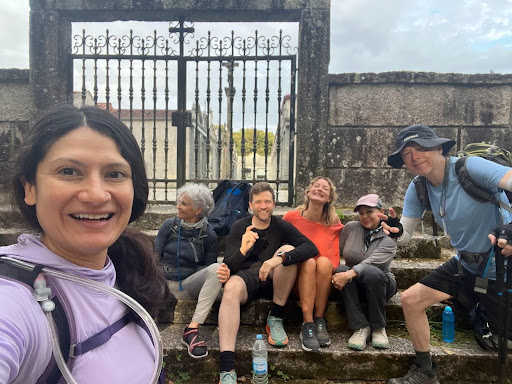
The following morning, we set off and loved this section of the trail as we came across various pop-up vendors selling snacks. We of course stopped for coffee.
That evening we made it to Pontevedra. I highly recommend you walk around this historic town. I loved the art, church, and cafes!
Tip: Eat the Caldo Gallego (Galician Broth) in Spain, we had it at “A Pousada do Peregrino” cafe in Barro.
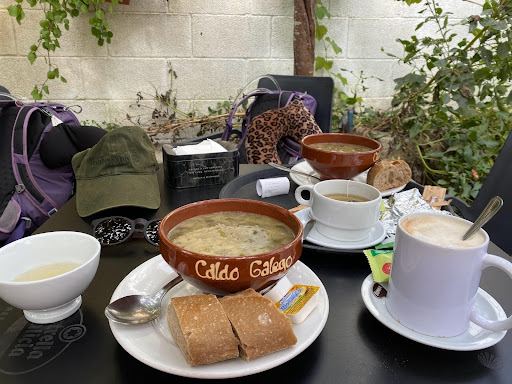
A note on the weather: It rained on day 10 of the Camino. I wore shorts, and my Patagonia rain jacket with a poncho since my pack didn’t have a rain cover! Thankfully I had my Oboz Katabatic Mid waterproof shoes which held up well in the rain.
Tip: In Padron, we had an amazing meal at Pulperia Rial. Make sure to make reservations. It gets busy.
Our last day on the Camino took place on October 14. The route took us through some cute villages and forests. On this, we met up with some pilgrims we had met in Rubiães a week prior. It was nice catching up and hearing tales of hardships on the trail, but continuing anyway!
The day was long, 16.5 miles to be exact. We made it to Santiago de Compostela at 5:41 p.m. Mom and I were ecstatic to arrive. When we finally made it to the offices to receive our Compostela (certificate), Mom and I broke out in tears, as the woman awarding us congratulated us. We had completed something amazing together!
Compostella de Santiago is very touristy, but make sure to visit the church and get some mementos.
Lessons & Closing Thoughts

I can’t detail everything in one blog post, but I hope this gives you some ideas on what to expect and what to consider. I would do the Camino again in a heartbeat. I know it will not be the last time I walk it. If you are considering doing the Camino, do it. You will not regret it.
Tip: Make sure to follow the arrows, not your phone GPS as sometimes the phone GPS tried to take us on busy highways. You should also use the Buen Camino Apps for trail maps, stays, meal planning, and more!
*This post may contain affiliate links that help us to keep the #52HikeChallenge thriving! Thank you for your support.
Check out Karla and our other Oboz ambassadors and don't forget to subscribe to our newsletter to stay up to date!
